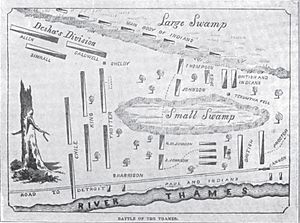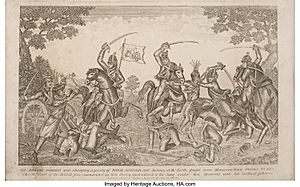Battle of the Thames facts for kids
Quick facts for kids Battle of the Thames |
|||||||
|---|---|---|---|---|---|---|---|
| Part of Tecumseh's War and the War of 1812 | |||||||
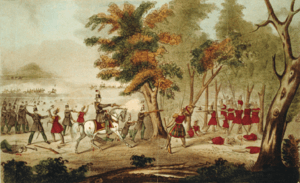 An artist's depiction of the battle and the death of Tecumseh |
|||||||
|
|||||||
| Belligerents | |||||||
| Tecumseh's confederacy |
|||||||
| Commanders and leaders | |||||||
| Tecumseh † |
|||||||
| Strength | |||||||
|
1,100–1,800:
|
3,760+:
|
||||||
| Casualties and losses | |||||||
| Indigenous: 16–33 killed Unknown wounded and captured British: 12–18 killed 22–35 wounded prisoners 566–579 captured |
10–27 killed 350 casualties (Kentucky mounted force broken) 17–57 wounded |
||||||
The Battle of the Thames /ˈtɛmz/, also called the Battle of Moraviantown, was an important American victory during the War of 1812. It happened on October 5, 1813, in what is now Ontario, Canada. In this battle, American forces fought against a group of Native American tribes led by Tecumseh and their British allies.
The British and their Native American allies were forced to retreat after the American navy took control of Lake Erie. The British commander, Major General Henry Procter, and the Shawnee leader Tecumseh led their forces up the Thames River. American soldiers, led by Major General William Henry Harrison, chased after them. The Americans first defeated the British troops. Then, they fought the Native American warriors. Tecumseh was killed during the battle, which greatly weakened the Native American alliance he had built. This victory helped the United States regain control of the Detroit area.
Contents
Why the Battle Happened
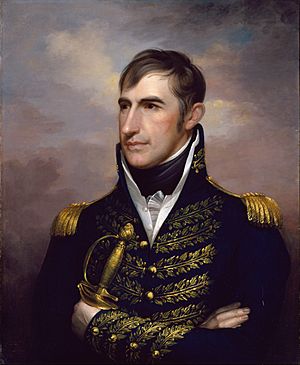
In 1812 and 1813, the American Army of the Northwest wanted to take back Fort Detroit. They also aimed to capture Fort Malden in Amherstburg, Ontario. These forts were held by British forces under Major General Henry Procter.
The British relied on Lake Erie to get supplies. The area around them did not produce enough food for their soldiers, sailors, and the many Native American families allied with Tecumseh. Supplies usually came by water from Long Point, at the eastern end of Lake Erie. If the Americans controlled the lake, they could cut off British supplies. They could also land troops on the north shore, stopping British reinforcements.
The British navy controlled Lake Erie until July 1813. But the United States Navy was building its own fleet. This new American fleet was led by Master Commandant Oliver Hazard Perry. In July, the British tried to block Perry's ships. However, they had to leave for two days to get supplies. This allowed Perry to move his ships onto the lake.
Perry's stronger fleet then blocked the British at Amherstburg. Food and supplies quickly ran out for the British. On September 10, the British commander, Robert Heriot Barclay, sailed out to fight Perry. But Perry won a complete victory in the Battle of Lake Erie. After this win, Perry quickly sent a message to General Harrison. He wrote, "We have met the enemy and they are ours." Harrison knew the British would have to retreat. So, he ordered his army to advance.
British Retreat from Detroit
General Procter had already planned to fall back to Burlington Heights. This was a British position at the western end of Lake Ontario. Tecumseh knew this retreat would leave his people's lands unprotected. He tried to convince Procter not to run away.
Tecumseh told Procter that their ships had fought, and they heard the guns. But now, Procter was preparing to leave without telling his Native American allies his plans. Tecumseh compared Procter's actions to a scared animal running away.
However, Procter could not defend Fort Amherstburg. There was no food, and the fort's cannons had been moved to Barclay's ships. So, Procter began to retreat up the Thames River on September 27. Tecumseh and his warriors had to go with him. Procter seemed to agree to retreat only to Moraviantown. This was a settlement of Lenape Native Americans. It was the highest point on the river that ships could reach, making it safe from water attacks. Some supplies could also be brought there by land. But Procter did not build any defenses at this spot.
The British retreat was poorly managed. Soldiers were given only half their usual food. Procter reportedly left his main army behind. He went ahead with his family and personal belongings. The British soldiers became very discouraged. Tecumseh's warriors grew impatient because Procter would not stop and fight.
The Americans left some troops to guard Detroit and Sandwich, Ontario. Harrison led his main army from Sandwich to chase Procter on October 2. As they moved, Harrison's men captured abandoned boats and British soldiers who had fallen behind. They caught up with the British and Native Americans on October 4. Tecumseh fought the Americans near Chatham, Ontario to slow them down. But his warriors were quickly outnumbered. The boats carrying British ammunition and food were captured by the Americans.
Who Fought in the Battle
General William Henry Harrison had at least 3,500 American soldiers. This included a small group of regular U.S. Army soldiers. He also had five groups of Kentucky militia, led by Isaac Shelby. Shelby was the 63-year-old governor of Kentucky and a hero from the American Revolutionary War. About 1,000 volunteer cavalry (soldiers on horseback) were led by Colonel Richard Mentor Johnson. Many of Johnson's men were from Kentucky. They were motivated by the cry "Remember the River Raisin," referring to an earlier battle.
General Procter had about 800 British soldiers. Most were from the 41st Regiment. These soldiers had been fighting in Canada since 1803. Many had been hurt or killed in earlier battles, including the Battle of Lake Erie. They had been joined by younger soldiers. Many British officers were unhappy with Procter's leadership. Tecumseh led about 500 Native American warriors.
The Battle Begins
On October 5, Procter ordered his troops to leave their breakfast and retreat another two miles. He then set up his soldiers in a battle line with one cannon. He hoped to trap Harrison's army near the Thames River. He wanted to use cannon fire to stop the Americans. However, he did not build any defenses like abatis (fallen trees) or earthworks. The ground was open, making it easy for American horsemen to attack. Scattered trees also hid the British fire.
Tecumseh's men formed a line in a swamp on the British right side. They planned to attack the Americans from the side. Tecumseh rode along the British line, shaking hands with each officer. Then he returned to his warriors.
General Harrison looked at the battlefield. He ordered James Johnson, Colonel Johnson's brother, to attack the British soldiers head-on with his mounted riflemen. Even with Native American fire from the side, Johnson's Kentuckians broke through. The British cannon did not fire. The British soldiers were tired, discouraged, and hungry. They fired only one messy volley before running away. Procter and about 250 of his men fled the battle. The rest of his soldiers dropped their weapons and surrendered.
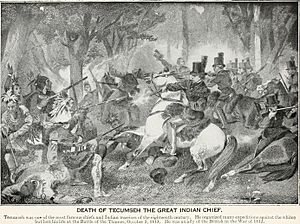
Tecumseh and his followers kept fighting. Colonel Johnson led about 20 horsemen into the Native American position. He wanted to draw attention away from the main American force. But Tecumseh and his men fired their muskets, stopping the cavalry charge. Fifteen of Johnson's men were killed or wounded. Johnson himself was hit five times. His main force got stuck in the swamp mud.
Many believe Tecumseh was killed during this fighting. The main American force finally moved through the swamp. James Johnson's troops were then free to help. As news spread of Tecumseh's death, Native American resistance ended. Richard Mentor Johnson was given credit for shooting Tecumseh, but the exact details are not clear. William Whitley, a veteran of the Revolutionary War, is also said to have killed him.
After the Battle
The American victory at the Thames helped the United States regain control of the Northwest frontier. The Detroit area remained mostly peaceful for the rest of the war.
Tecumseh's death was a huge blow to the Native American alliance he had built. The alliance broke apart after the battle. Harrison signed a peace agreement with several tribes in Detroit. Some tribes, however, continued to fight. Harrison then moved most of his regular soldiers east. He went to Washington, D.C., where he was celebrated as a hero.
Later, Harrison had a disagreement with President James Madison. This led him to resign his position as a major general. However, Harrison's popularity grew, and he was eventually elected president. Richard Mentor Johnson later became vice president. This was partly because many believed he had personally killed Tecumseh.
A few days after the battle, General Procter gathered 246 men from the 41st Regiment. They were joined by some young soldiers who had not been in the battle. The two groups were combined because the regiment had lost so many men. The soldiers of the 41st who were captured were later released in late 1814. They had been held in camps and suffered from sickness.
In May 1814, Procter was accused of poor leadership. A military court decided that Procter had managed the retreat badly. They also said he had not set up his troops effectively at Moraviantown. He was suspended from his rank and pay for six months.
Legacy
Three modern groups of the United States Army continue the history of the old 27th Infantry Regiment. Parts of this regiment fought at the Battle of the Thames.
More Information
Here are some of the units and commanders who fought in the Battle of the Thames:
- Abbreviations used
- MG = Major General
- BG = Brigadier General
- Col = Colonel
- Ltc = Lieutenant Colonel
- Maj = Major
- Cpt = Captain
- Lt = 1st Lieutenant
- w = wounded
- k = killed
- m = missing
American Forces
Army of the Northwest: MG William Henry Harrison
General Staff
- Inspector-General: Col George Walker
- Military Secretary: Maj William T. Barry
- Judge Advocate General: Maj Thomas Barr
- Adjutant General: Joseph McDowell
- Aide-de-Camp: Oliver Hazard Perry
- Aide-de-Camp: BG Lewis Cass
| Unit | Regiments and Other |
|---|---|
| U.S. Regular Army |
|
| Kentucky Mounted Riflemen
|
|
Kentucky Militia
Governor Isaac Shelby
General Staff
- 1st Aide de Camp: BG John Adair
- 2nd Aide de Camp: Maj John J. Crittenden
- Quartermaster General: BG John Payne
| Division | Brigade | Regiments and Others |
|---|---|---|
|
1st Division |
First Brigade
|
|
| Second Brigade
|
|
|
| Fourth Brigade
|
|
|
|
Second Division |
Fourth Brigade
|
|
| Fifth Brigade
|
|
|
| Unattached
|
|
British and Native forces
Major General Henry Procter
British
- 41st (Welsh) Regiment of Foot: Col Augustus Warburton
- Local militia (composition unknown)
Tecumseh's confederacy
See also
 In Spanish: Batalla del Támesis para niños
In Spanish: Batalla del Támesis para niños


